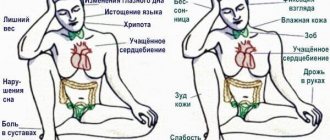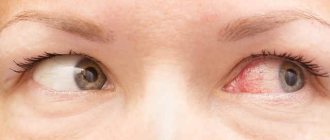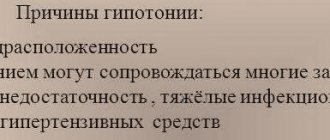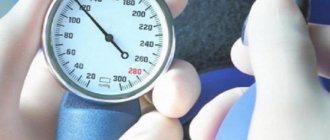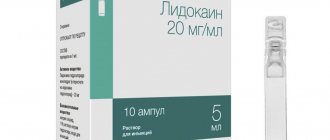When treating glaucoma, the doctor uses all methods to reduce increased intraocular pressure. This, in turn, helps reduce the amount of damage to the optic nerve. As a rule, in the initial stages of the disease, eye drops are used that eliminate intraocular hypertension. An important condition for effective treatment is regular use according to the instructions written by the doctor. If monotherapy is not effective enough, the ophthalmologist usually prescribes eye drops from a different chemical group. These drugs may potentiate each other's effects.
Since all eye drops that are used to treat glaucoma are absorbed into the choroidal vessels, they can penetrate into the systemic circulation in small quantities. Some components of antiglaucoma medications negatively affect the functioning of the heart, blood vessels, and respiratory system. Therefore, it is very important for the doctor to know if the patient has any systemic chronic diseases. If the patient for some reason (health status, low adherence) is not able to regularly instill glaucoma medications, then it is better to choose an alternative method of treatment.
What is eye pressure?
Pressure in the eyes is a fairly common pathology, however, it is also very dangerous, as it can provoke the spread of a disease such as glaucoma and completely deprive a person of vision. When talking about signs of eye pressure, experts first of all name headaches, often migraines, which tend to intensify during a cold.
What pressure is normal? Most ophthalmologists are inclined to the following indicators: 8-26 mm Hg. Art. If for some reason the body experiences stress, the eye secretion increases, which, in turn, entails disruption of the cardiovascular system. It is at this time that the pressure inside the eyes begins to increase.
Causes of increased pressure in the eyes
Looking ahead, we will say that before prescribing drops, the ophthalmologist checks the size of the eyeball and looks for the causes of eye pressure, since it often accompanies many diseases, including those related to the visual organs. So, what are the key factors that experts highlight:
- stress;
- constant overwork, both mental and physical;
- hypertension;
- thyroid diseases;
- renal and heart failure;
- neuralgia;
- transformation in the structure of the eyes;
- injury or inflammation of the eyeball;
All of the above ailments entail pain in the temporal lobe, as well as painful sensations when a person begins to move his eyes. This is often accompanied by general weakness and lethargy. Drops to reduce eye pressure are prescribed in order to improve not only the general condition, but also to relieve a number of uncomfortable sensations. For example, fatigue, redness, headaches, and also reduce the deterioration in visual acuity and clarity.
Let us remind you that eye pressure drops are not able to solve the problem once and for all, for example, eliminate hypermetropia, myopia or astigmatism, but they will help stop the development of the disease and its worsening. Especially if the diagnosis of the disease occurred at the first stage: in this case, with good accommodation of the eyes, glasses and contacts are not prescribed, much less surgical intervention is performed. The use of eye drops is one of the effective non-surgical methods for stopping such a progressive disease as glaucoma.
How to treat illness and its prevention?
The most effective treatment for elevated intraocular pressure is surgical intervention. This is the most radical way. They resort to it if it was not possible to achieve the desired result with the help of physiotherapeutic procedures such as vacuum massage or color pulse therapy.
prophylaxis will help prevent both the operation and, in fact, the onset of illness . If you are at risk, it is incredibly important to adjust your own diet. You should limit the consumption of salt and fast carbohydrates, and enrich the menu with vegetables, red fruits, and dark chocolate.
You should also avoid clothes that have tight collars. You should not tighten your tie and unbutton the top button. In another case, the outflow of blood that comes from the veins of the head is disrupted.
It is recommended to minimize visual and physical stress. Try to avoid emotional stress and overload. As a preventive measure, it is better not to drink excessive amounts of liquid and forget about tea and coffee altogether.
What types of eye drops are there?
Today, ophthalmology offers a wide range of medicines that will help solve a number of problems, and some - several at the same time. Under no circumstances buy drugs on your own, as you can harm yourself and start processes that cannot be stopped. If you feel unwell, make an appointment with an ophthalmologist: perhaps it’s just fatigue taking its toll, or perhaps it’s time for you to resort to medications.
So, experts distinguish the following types of drops according to their therapeutic value:
- the former reduce the production of intraocular secretion;
- the latter stimulate the outflow of fluid.
There are drops that are a combined form, and combine both the first and second effects of the above. There are also drops that differ in their composition:
- beta blockers;
- prostaglandins;
- Cholinomimetics.
We will explain what this means below.
Which drops for eye pressure should I choose?
So, drops are distinguished by therapeutic purpose and composition. Which ones do you need? Only a specialist can answer this question. Drugs are prescribed individually based on the diagnosis and physiology of the patient. Drops to reduce intraocular secretion are also called beta-blockers. They work to eliminate receptors that produce moisture. They are extremely effective and can lower blood pressure by up to 25%, which is why they are most often prescribed for the treatment of glaucoma and ocular hypertension. The latter pathology does not entail loss of vision. This type of medicine includes:
"Timolol" and "Betoptik". However, they also have their own characteristics. For example, they cannot be used when there is a pathological process in the cornea, there is pulmonary obstruction, there is cardiac arrhythmia or heart failure. Drops that lead to the outflow of fluid include Xalatan. It is quite gentle and has no side effects. But with prolonged treatment, it provokes active eyelash growth. Ophthalmologists do not recommend using drops just for the sake of a cosmetic effect - this can negatively affect vision. In addition, frequent use of the drug does not help lower blood pressure, but reduces its effectiveness. This same group of drops includes “Travatan”, which also improves the outflow of fluid. On the plus side: it works well together with other drugs aimed at eliminating glaucoma. Ophthalmologists say that with regular use of this product, blood pressure can be reduced by 30% (which is quite a large figure).
Please be aware that headaches, irritation, swelling and watery eyes may occur.
We have already talked above about drops of combinatorial action. This is truly a new word in ophthalmology, since they have an effect due to a mix of drugs of different types, each of which is aimed at eliminating glaucoma. Also among the obvious advantages is the absence of contraindications. They are much more expensive, but do not require long-term use.
Such drugs include:
- "Fotil", which reduces blood pressure and constricts the pupils. The effect appears after 10 minutes and lasts several hours;
- "Timolol", which penetrates the structures of the ciliary body and helps reduce the secretion of intraocular fluid. Plus, it promotes better blood circulation;
- "Latanoprost." Characterized by rapid penetration through the cornea. Excreted naturally;
"Cosopt" not only reduces eye pressure, but also minimizes the production of eye secretions. As a result, moisture does not accumulate in the eye, causing deformation or putting pressure on the optic nerve.
Principles of glaucoma therapy
- Treatment begins with the prescription of one first-choice drug, and if it is ineffective, it is replaced with the next first-choice drug or a combination treatment is prescribed (two first-choice drugs or a first-choice drug and a second-choice drug);
- In case of intolerance or in case of contraindications to treatment with first-choice drugs, therapy begins with the prescription of second-choice drugs;
- For combination therapy, combined antiglaucoma drugs are prescribed;
- In combination therapy, drugs that have the same mechanism of action are not used;
- Long-term treatment requires periodic replacement of medications.
In the medical department, everyone can undergo examination using the most modern diagnostic equipment, and based on the results, receive advice from a highly qualified specialist. The clinic is open seven days a week and operates daily from 9 a.m. to 9 p.m. Our specialists will help identify the cause of vision loss and provide competent treatment for identified pathologies.
In our clinic, appointments are carried out by the best ophthalmologists with extensive professional experience, the highest qualifications, and a huge amount of knowledge. The cost of glaucoma treatment at MGK is calculated individually and will depend on the volume of treatment and diagnostic procedures performed.
We draw your attention to the convenient location of the clinic, the presence of its own hospital, as well as many positive reviews from patients. Prices for medical services at MGK are affordable and fixed in the contract. The cost of diagnosing and treating glaucoma can be found here.
All questions you are interested in can be asked to specialists by phone or online using the appropriate form on the website.
What is included in the drops? What are they?
As mentioned above, there are three types of drops in their composition: beta blockers, prostaglandins and cholinomimetics. The first group of drops is suitable for people who have high eye pressure. Such drugs begin to act within half an hour. Below we provide eye drops for pressure. Here is a list of the most popular beta blockers:
- "Arutimol", which lowers blood pressure, but does not in any way affect visual acuity. It is prescribed to patients diagnosed with open and aphakic glaucoma, chronic closed or congenital glaucoma;
- "Ocumed." It also works to lower blood pressure and is designed for people with ocular hypertension, open, closed or congenital glaucoma. It is prescribed to children under ten years of age.
Of course, you should not prescribe the drug yourself under any circumstances, since if used incorrectly, you may experience, at a minimum, unpleasant sensations. If you feel pain, swelling or itching, stop treatment immediately and consult a specialist.
Adverse reactions from the use of drops
Side effects from the body are individual, often they are a reaction to the components of the drug. As a result of application, the following effects are possible:
- cholinomimetics - the drug provides constriction of the pupil and promotes better removal of excess fluid, blurred vision and burning may occur;
- sympathomimetics - these can cause red eyes, change blood pressure, and affect heart rate.
- prostaglandins - as a result of using the drug, the patient may feel a slight burning sensation and a red eye effect.
The most common side effect from using the drops is a burning sensation that subsides after a while.
If alarming symptoms appear, you should inform your doctor about them and, if necessary, stop taking the drug.
Additional Treatments
Even the most innovative drops for reducing eye pressure work best only in combination with a healthy lifestyle and eye exercises. Also, do not forget about some simple, but at the same time effective rules that will help stabilize vision and prevent the progression of the disease. Ophthalmologists strongly recommend watching TV or working at a computer for no more than two hours at a time, and then doing gymnastic exercises and giving your eyes a rest. Limit consumption of salt, coffee, energy drinks and strong teas, as well as alcohol. Additionally, if you have been diagnosed with chronic eye pressure, it is not recommended to lift heavy objects, as this can cause damage to the optic nerve. Experts, in addition, advise sleeping on a volumetric pillow - this way the head will be higher than the level of the body, which, in turn, will help to avoid increased pressure. You should use the drops strictly according to the instructions and constantly visit a specialist to monitor the disease.
From traditional medicine
Medicines alone cannot get rid of eye pressure problems. Achieving results is possible only by normalizing the daily routine, enriching the diet with nutrients and eliminating the influence of unfavorable factors. The Council of Traditional Medicine makes the following recommendations:
- Normalization of pressure is facilitated by gymnastics for the eyeballs, which should be performed regularly; the simplest exercise is to focus your vision on a nearby object;
- limit the time spent at the computer, reading, watching TV programs;
- reduce the amount of fluid consumed;
- It is prohibited to lift heavy loads exceeding 10 kg; such actions can damage the optic nerves.
It is recommended to sleep in an elevated position, with your head above body level. For preventive purposes, it is recommended to consume large amounts of blueberries. Good results are achieved by using decoctions based on oak bark and fennel seeds.
How to instill drops to relieve pressure?
Pressure lowering products are extremely easy to use. The most important rule that should be observed and which should not be neglected is cleanliness of hands. If you get an infection, then, at a minimum, you will develop conjunctivitis, which, given existing diseases, causes the most unpleasant sensations.
To apply eye drops, you should tilt your head back and drop the drug into the inner corner of the eye, after slightly moving the lower eyelid. Be careful, don't get distracted. It is very important not to let the tip of the pipette or pipette come into contact with your eye. After the procedure, you need to close your eyes for a few seconds. To store drops, choose places where there is no direct sunlight, read the manufacturer's instructions and follow the recommendations of your doctor.
Do not forget to visit your ophthalmologist in a timely manner and regularly measure the pressure inside your eyes. This approach will help you accurately select the drug and its dosage; this is extremely important for the treatment to be successful. Do not delay visiting an ophthalmologist if you experience pain or discomfort when working with documents or at the computer, or when watching TV. Regularly make an appointment with a specialist, observe the rules of personal hygiene and, if you have existing diseases, constantly monitor your well-being.
MagazinLinz.ru team
